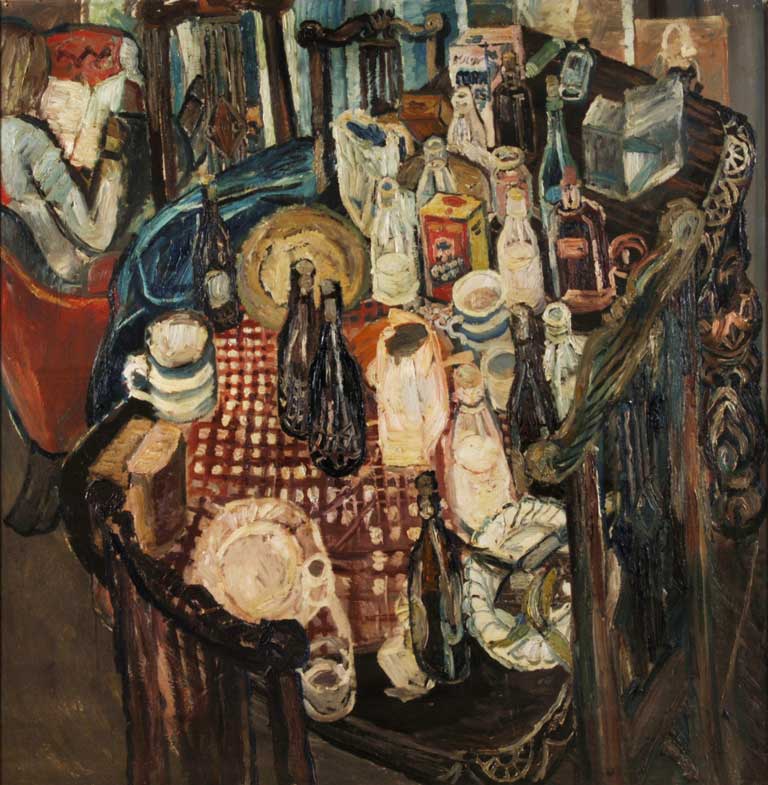Great Works: Table Top, 1955, by John Bratby
Portsmouth City Museum and Art Gallery

Let's admit it, a table top can be a nasty and unruly place. In fact, it can be all over the place – as it is here. It is where objects wash up and refuse to budge. We do not necessarily want them like that, but we do not stop them being what and where they are. This painting, composed as it is of multiple elements of what might, in the hands of a Cézanne or a Braque or a Morandi, have been a harmoniously composed still-life painting, seems to be some kind of a jokey travesty of, or irreverent commentary upon, the same.
Cézanne's still lifes seem to be distillations of thinking, all caution and quiet, set-apart consideration. We wonder about the nature of perception, the essence of appleness. This is nothing of the kind. It is an almighty clash of cymbals. It is utterly of this world in which we all think, move and breathe.
It is a roughly hewn-off segment of reality upon which we all happen to have stumbled, like it or not. And we don't like it, not very much, because it utterly fails to flatter or to idealise reality. Where Cézanne distils, this sprawls – into the telling of an everyday story. Life could be other than it is, but it just happens to be this, because this is how things are. It gives the lie to the idea that a bunch of bottles might be indicative of profound inner harmonies or still points in a turning world or moments of revery.
It is not so much a smooth coming together as a dissonant clashing together of elements, which is saying to us: all this is human detritus after all. Why pretend otherwise? It is what you all boil down to in the end. It is what is left behind after the scoffing and the swilling is over. This is what the human engagement with bottles and jugs and jars and plates and cups really means: once they have fulfilled their usefulness, we leave them behind as a messy clutter. They are our autobiography, the embarrassing part, like the dirt beneath our finger nails.
That is why the reader of the newspaper in the chair we can see top left has her back turned to the scene, quite pointedly so. She – is it a she? – is pretending that she lives in a world of cerebral concerns, that reading and thinking seriously about what she has just read are her game. The opposite may be the truth. It is what is at her back – and directly in front of us, the onlookers – which is what she amounts to, and this includes a significant element of mess and squalor. Everything seems to work together to emphasise the fact that things are falling apart. There is gawkiness, odd over-extensions – why, for example, is that chair at bottom right of the painting so much taller than its companion just to the left of it?
The viewpoint is rather unusual too; the way we look down on this scene. We feel slightly vertiginous as we work our way across it. We feel as if we might stumble and fall into its messy centre. The scene seems to yawn and spread and stretch away from us, like spilled liquid from a knocked-over jug. It is difficult to get the measure of the shape of this table. Is it squarish with rounded corners (it seems so when looked at from the end closest to the bottom edge of the canvas) or not?
Yet when our eyes examine other parts of it, we become less sure. Is that chequered table cloth half hanging off, and if so, why? Is this the aftermath of an almighty booze up or the general detritus of a multiplicity of meals, including breakfast (see Quaker Oats), a bibulous lunch (see wine bottles) and tea (see mug with the blue and white stripes)? Is that the remnant of a kipper or the discarded skin of a banana that I see before my eyes at bottom right? It is difficult to fathom where all this quite begins and ends. The table, no matter what shape it really is, can barely contain all this squalor.
Well, it was always said that Bratby lived a racy and dangerous life, so this is probably just a snippet of it.
About the artist: John Bratby (1928-1992)
In the 1950s, John Bratby was regarded as a tough-minded British realist, on the kitchen-sink side of art's table. Later on, his work became more delicate and his colours brighter. He ditched his earlier austerity for a style which seemed to be ready to make its compromises with the variousness of the world, and even to delight in such things as flowers. He was also a novelist and able art critic.
Join our commenting forum
Join thought-provoking conversations, follow other Independent readers and see their replies
Comments